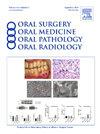Premalignant changes in odontogenic keratocyst of a 14-year-old patient
IF 1.9
3区 医学
Q2 DENTISTRY, ORAL SURGERY & MEDICINE
Oral Surgery Oral Medicine Oral Pathology Oral Radiology
Pub Date : 2025-07-21
DOI:10.1016/j.oooo.2025.04.028
引用次数: 0
Abstract
Introduction
Odontogenic keratocyst (OKC) is known for its characteristic behavior, aggressive growth pattern, and a high tendency to recur. Dysplastic change in an OKC is an infrequent phenomenon.
Case Report
We report an unusual case of an OKC, exhibiting premalignant changes, in the anterior mandible of a 14-year-old female. The lesion was an incidental finding during a routine dental examination. The patient was asymptomatic, and no signs of swelling or cortical expansion were noted. Radiographically, it presented as a unilocular, well-defined, expansile radiolucency with partially corticated margins. There was a marked divergence of mandibular incisors and canine. The patient exhibited palmar pitting, as seen in Gorlin-Goltz syndrome. Histologic evaluation of the incisional biopsy showed moderate to severe dysplastic changes in the lining epithelium. The cyst was enucleated 2 months later and the biopsy revealed changes consistent with severe dysplasia and focal carcinoma in situ. Atypical changes such as nuclear hyperchromatism, increased nuclear/cytoplasmic ratio, loss of cellular polarity, dyskeratosis, and atypical mitoses were observed. Occasional teardrop-shaped budding of the lining epithelium was present. The underlying connective tissue displayed an intense inflammatory infiltrate and scant germinal centers. The patient will be periodically re-evaluated and followed up closely.
Conclusion
Epithelial dysplasia in OKC is not a common occurrence. Whether OKCs with epithelial dysplasia have a higher recurrence and/or should be treated differently than OKCs without dysplasia, especially in syndromic patients, remains uncertain. Should dysplasia be considered a predictive factor for the recurrence of an OKC? Since many OKCs may not recur until 10 years or more after the initial treatment, a long-term follow-up, including periodic radiographic imaging, is recommended.
14岁患者牙源性角化囊肿的癌前改变
牙源性角化囊肿(OKC)以其特有的行为、侵略性的生长方式和高复发倾向而闻名。发育不良的改变在OKC是一个罕见的现象。病例报告我们报告了一个不寻常的病例OKC,表现出癌前病变,在一个14岁的女性前下颌骨。这是一次例行牙科检查时偶然发现的。患者无症状,没有肿胀或皮质扩张的迹象。影像学表现为单眼,界限分明,放射透光度扩大,边缘部分皮质化。下颌门齿与犬齿有明显的差异。患者表现出手掌凹陷,如Gorlin-Goltz综合征所见。切口活检的组织学评估显示衬里上皮有中度至重度的发育不良改变。2个月后,囊肿被去核,活检显示的变化与严重的不典型增生和局灶性原位癌一致。观察到不典型的改变,如核深染,核/细胞质比增加,细胞极性丧失,角化不良和不典型有丝分裂。偶见泪滴状上皮出芽。结缔组织显示强烈的炎症浸润和缺乏生发中心。患者将定期复查并密切随访。结论上皮异常增生在OKC中并不常见。上皮发育不良的OKCs是否有更高的复发率和/或是否应该与没有发育不良的OKCs区别对待,特别是在综合征患者中,仍然不确定。发育不良应该被认为是OKC复发的预测因素吗?由于许多OKCs可能在初始治疗后10年或更长时间才复发,因此建议进行长期随访,包括定期放射成像。
本文章由计算机程序翻译,如有差异,请以英文原文为准。
求助全文
约1分钟内获得全文
求助全文
来源期刊

Oral Surgery Oral Medicine Oral Pathology Oral Radiology
DENTISTRY, ORAL SURGERY & MEDICINE-
CiteScore
3.80
自引率
6.90%
发文量
1217
审稿时长
2-4 weeks
期刊介绍:
Oral Surgery, Oral Medicine, Oral Pathology and Oral Radiology is required reading for anyone in the fields of oral surgery, oral medicine, oral pathology, oral radiology or advanced general practice dentistry. It is the only major dental journal that provides a practical and complete overview of the medical and surgical techniques of dental practice in four areas. Topics covered include such current issues as dental implants, treatment of HIV-infected patients, and evaluation and treatment of TMJ disorders. The official publication for nine societies, the Journal is recommended for initial purchase in the Brandon Hill study, Selected List of Books and Journals for the Small Medical Library.
 求助内容:
求助内容: 应助结果提醒方式:
应助结果提醒方式:


